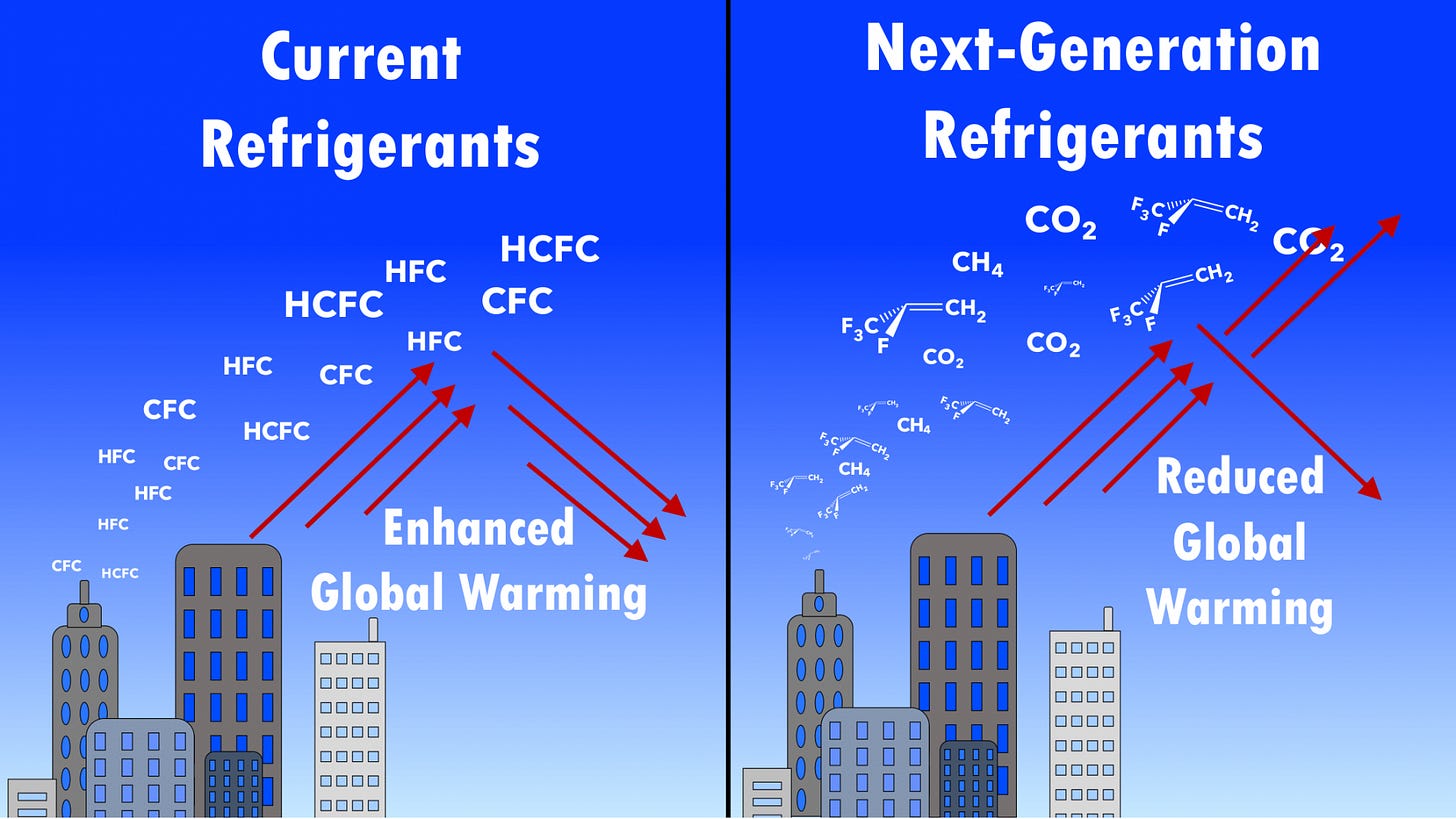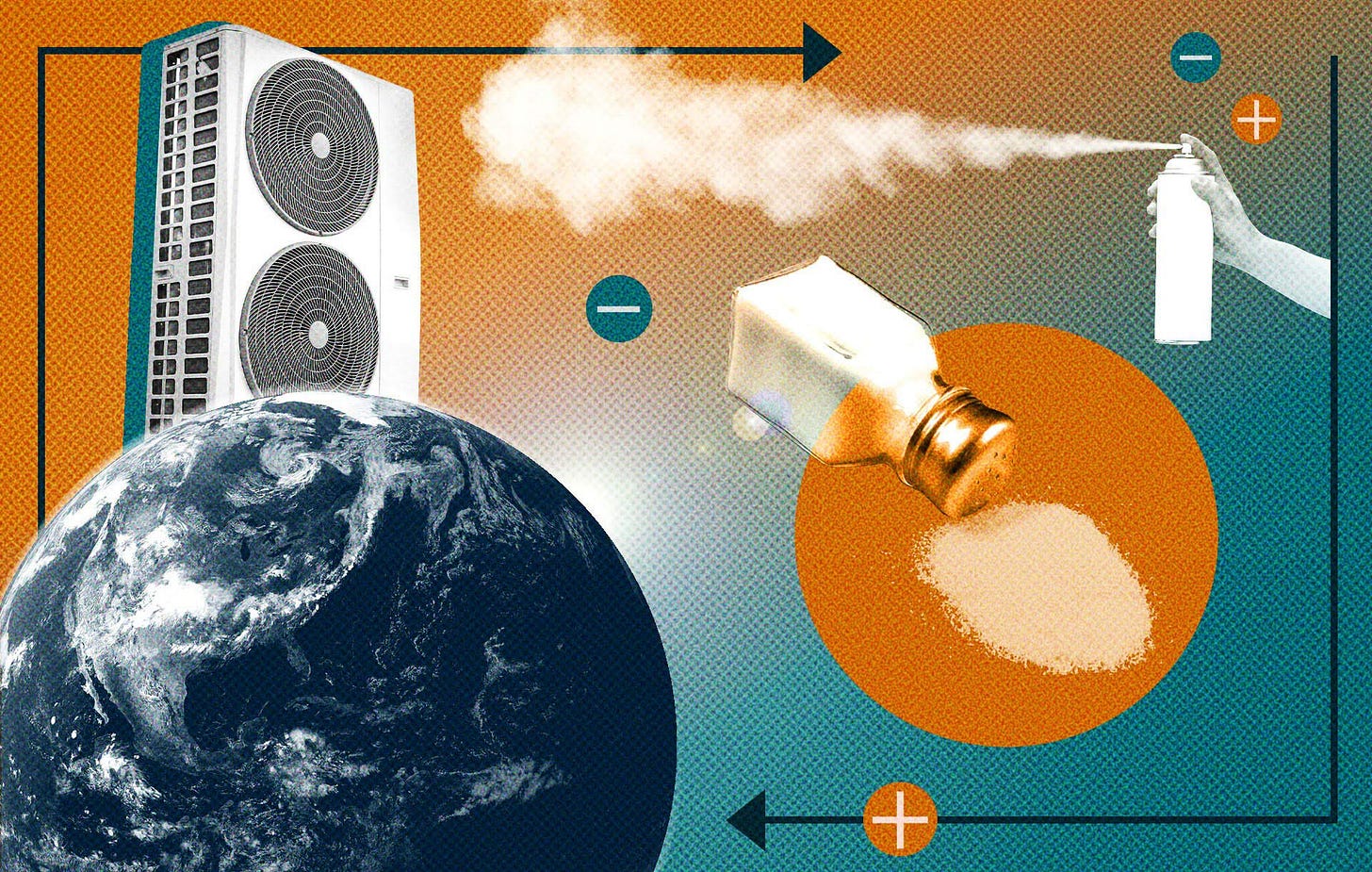Welcome to the first edition of Terreminder, a newsletter focusing on Green Tech, Energy, and Climate Resilience. Once a week, you’ll receive a compilation of relevant developments as well as one longer story on a selected topic. I will probably change the format several times as we move forward and will be very grateful for any feedback that helps me improve this newsletter. And now, enjoy the read!
Hamburg, early January.
I am pushing the stroller towards the kindergarten.
The sky is gray. So far, so normal. Northern Germany, after all…
But it's cold. Really c-c-c-cold.
I can tell because I'm not wearing gloves and my hands are slowly but surely freezing to the handle of the stroller.
The reaction of my Homer Simpson brain?
It thinks about the Hamburg Freezers.
"What the puck?”
Well, yes, the local ice hockey team. Based in Hamburg from 2002 to 2016, before running out of cash.
From the Freezers, my mind hockey then leads me to a question:
What about the climate impact of freezers and fridges?
Are they still climate killers? Or have they become cooler?
The big problem: refrigerants.
Today, they are mostly based on fluorinated gases that do not occur in nature.
For a long time, chlorofluorocarbons (CFCs) were the refrigerants of choice. However, in the 1980s, scientists realized that CFCs destroy the ozone layer. The Montreal Protocol of 1989 was pretty successful in regulating the substances, allowing the ozone layer to partially regenerate as a result.
Hydrofluorocarbons (HFCs) entered the stage as a substitute. While HFCs do not damage the ozone layer, they usually have a significantly higher global warming potential than CO2. The GWP value (Global Warming Potential) of some F-gases is 100 x to 12,000 x higher than that of CO2!
Sounds like another case of "plague or cholera"...
Credit: MIT Science Policy Review | Source
In 2016, the Montreal Protocol was expanded to include the Kigali Amendment.
The aim is to significantly reduce the use of HFCs by 2047.
The F-Gas Regulation has been in force in the EU since 2006 and was last updated in 2014 and 2023. With this regulation, the EU Commission aims to reduce the use of HFCs by 95% by 2030 compared to 2015. They are to be completely eliminated by 2050.
According to the EU Commission, fluorinated gases account for around 2.5% of the EU's greenhouse gas emissions. Around 90% of F-gas emissions are accounted for by HFCs, i.e. hydrofluorocarbons.
Are there already sustainable refrigerants?
Sustainable, natural alternatives have actually always existed.
These include air and water, but also CO2, ammonia and hydrocarbons such as isobutane or propane. The latter were even used as refrigerants in the early 1920s. In the 1950s, they were replaced by CFCs and HFCs. They are now back in demand as substitutes. Isobutane is now used in many household refrigerators.
The Greenfreeze is a particular success story. The technology is based on short-chain hydrocarbons such as isobutane and propane. These substances do not damage the ozone layer and have a lower global warming potential.
Unfortunately, there is no one ultimate refrigerant, only the optimum refrigerant for a particular application. The good news: We have a more sustainable alternative for almost every existing refrigerant.
However, there is one catch: natural refrigerants are often toxic or highly flammable. Synthetic refrigerants, on the other hand, are safer, but contribute to the greenhouse effect.
Time for new alternatives…
New technologies: Magnetic cooling?
Several universities and companies want to use the magnetocaloric effect for climate-friendly cooling. The cooling effect is created by magnetizable alloys based on silicon, for example: magnetocaloric material is heated by magnetization.
The heat generated is then dissipated via a heat sink. As soon as the magnetic field is removed, the material cools below the initial temperature. It can now absorb thermal energy from a heat source. This cooling effect can be realized as a cycle.
Another version of caloric cooling is the ionocaloric cooling cycle. Researchers at the University of Berkeley in California are experimenting with a salt mixture as a refrigerant.
In this cooling circuit, sodium iodide salt melts and solidifies with ethylene carbonate. During melting, heat is extracted from the environment. This heat is released again during solidification.
Increasing efficiency: the most obvious solution
New technologies are attractive, but they are still a long way from replacing traditional compressor-based refrigerators.
Besides more sustainable refrigerants, the decisive factor is efficiency. It is the “low-hanging fruit.” More efficient refrigerants with low greenhouse gas potential would ensure a double climate protection effect.
Refrigerators with intelligent, demand-based controls that minimize the consumption of electricity and refrigerants will increase efficiency.
Credit: Jenny Nuss/Berkeley Lab | Source
Disposal of refrigerants: Cold, cold heart…
A large share of the emissions are caused by leaks and during the disposal of refrigerants. Refrigerant leaks are a major problem, as they release large quantities of greenhouse gases into the atmosphere. Recovery and recycling remain major challenges.
And by the way: Heat pumps (which are a building bloc of the energy transition) also use refrigerants. Ideally, the pump should therefore use a refrigerant with the lowest possible GWP (Global Warming Potential).
Conclusion: Time to ditch the fridge?
When it comes to their climate impact, most refrigerators today are anything but cool.
Synthetic refrigerants increase global warming. The large-scale transition to better alternatives will take time.
While we explore more sustainable cooling solutions, we should improve the efficiency of existing technologies.
International agreements such as the Montreal Protocol, the Kigali Amendments and, most recently, the Global Cooling Pledge signed by 50 countries show that the problem has at least been acknowledged.
Now action must follow.
Globally speaking, our cold is responsible for heat.
Better be cool - and cool better!
Transition Tracker
10 important news and developments in Energy, Green Tech, and Climate Resilience. In no particular order of importance.
Large-scale solar power in the Sahara? What sounds like a no-brainer, could actually have a negative impact on solar energy elsewhere, according to these findings.
The World Economic Forum’s Global Risks Report 2024 is out: Extreme weather events rank 2nd on the 2-year horizon. On the 10-year horizon the Top 4 are all about Climate and the Environment: Extreme weather events, critical change to Earth systems, biodiversity loss and ecosystem collapse, natural resource shortages. Talk about a new world order…
The IEA published its Renewables 2023 report. Key findings: Last year, the world's renewable energy grew at its fastest rate in the past 25 years. This was mostly thanks to China: The country installed as much solar power as the entire world did in 2022. The COP28 goal of tripling global renewable capacity from 2022 levels by 2030 is still within reach, but countries will have to step up their green game.
People seem to be more willing to act on climate change when they hear stories about climate migration within their own country, according to a new study conducted by researchers from the University of Michigan and other institutions. They suggest that stories that hit “closer to home” are more effective than reports about international climate migration.
In a reaction to a season of devastating forest fires and floods, the Greek government has replaced the country’s accomodation tax with a new “Climate Resilience levy”. The additional funds will help finance Greece’s special reserves budget for reconstruction efforts.
Climate change could further destabilize the MENA region, explain Kyungmee Kim and Tània Ferré Garcia in this article for the International Peace Institute’s Global Observatory.
“Your Tesla does not equate to a global energy transition”, warns DNV’s Sverre Alvik in his commentary for Forbes. He argues that the true start of the global energy transition will occur in the mid-2020s, when renewables will finally begin to “outsprint” fossil fuels.
Another reality check comes from the Global Energy Monitor: It tells us that globally, a staggering $910 billion is to be spent on gas pipelines and LNG facilities - in nearly all major regions.
The European Commission has approved German state aid of $902 million for the construction of an EV battery production site in the Northern state of Schleswig-Holstein. It is the first state aid approved under the Temporary Crisis and Transition Framework. The regulation was designed to keep investment in strategically important sectors within Europe by balancing out foreign state aid and subsidies.
Smart grids, maintenance, efficiency, weather modelling - AI has the potential to boost Green Energy in multiple ways, explains Zac Amos.
Quote of the Week
“We have been living in the age of energy addition rather than energy transition.”
Sverre Alvik, DNV
That’s it for today.
If you’ve made it all the way through, thank you very much.
If you enjoyed this newsletter, please share it with others and spread the word.
See you next week!
PS: Got any feedback? Please leave a comment below. Cheers!






Cool!